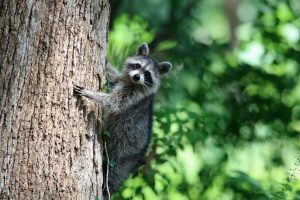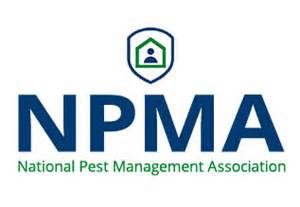Proudly serving Lake County IL, Eastern McHenry County and Northern Cook County
Raccoon Removal and Control

The raccoon is the most common animal that we deal with, probably due to its diverse habits and adaptable nature. In natural habitats raccoons populate woodlands, wetlands, prairies, etc. They will live wherever food, water and shelter are available. This adaptability is the reason that raccoons are so numerous in urban areas as well. . They make themselves at home in attics, crawlspaces, abandoned buildings, chimneys, under stoops, decks and outbuildings. The abundance of den sites in populated areas results in many conflicts between humans and raccoons.
Some of the common raccoon problems that we deal with include
▪ Raccoon removal from attics, chimneys, window wells, garages, crawlspaces and basements.
▪ We also trap raccoons from under decks, sheds, porches and any other structure that they find themselves comfortable.
▪ Sometimes controlling raccoons is required when they are causing damage to homes and other structures. This includes tearing holes in roofs and siding, getting into garbage cans, digging up lawns for grubs and worms & leaving piles of droppings in areas frequented by people, such as children’s play sets.
Raccoons in the urban environment utilize human dwellings and other buildings as their den sites of choice. They have successfully adapted to life within populated areas. The population numbers of raccoons in Illinois has increased over time despite urban sprawl. There are many different places in and around homes and other buildings that raccoons find to be safe and comfortable for denning.
Animal Control Specialists, Inc. is diligent in examining every raccoon captured to determine its gender. This is important to ensure that we are aware of the potential presence of a litter of young.
Raccoon Biology
Medium sized animal distinguished by the “mask” around their eyes and ringed tail.
▪ Weight: 12-35 pounds. (Average adult 15-20 pounds)
▪ Breed: January-February with a gestation period of 63 days.
▪ Young: # 1-8 (average 3-5) born in April and May. Presence identified by chirping, chattering noise.
▪ Diet: Being omnivorous, they will consume most anything. Animals (dead or alive), fruits, vegetables, pet foods and anything edible discarded by humans.
Habits:
Raccoons are chiefly nocturnal, occasionally active during the day.
Detrimental Consequences of Raccoons on Your Property
Raccoons can become a nuisance even if they are not living in or on your property. Some of the situations that we see on a regular basis are:
▪ Raccoons getting into trash cans.
▪ Raccoons knocking down bird feeders.
▪ Raccoons eating Koi from decorative ponds.
▪ Raccoons defecating on roofs and grounds in localized areas.
▪ Raccoons harassing pets.
▪ Raccoons entering open doors and windows to help themselves to food inside your home.
In some cases problems like these can be solved by changing our habits. Some examples would be securing garbage cans inside an enclosure, remove the feeders at night, install an electric fence around Koi ponds, try using repellents in areas frequented by raccoons or walking your pet on a leash. While some of these suggestions are feasible and we always recommend changes that provide long-term solutions, trapping and removing the particular animal that displays a bad behavior has proven to be very effective. It is likely that if you remove a racoon another one will fill its territorial niche in your neighborhood. However, the raccoon that moves in next will not necessarily exhibit the same bad behavior.
Raccoon Control Measures
Animal Control Specialists, Inc. has the knowledge, experience, expertise and ability to utilize all legal methods necessary to trap and remove your problem raccoon(s). Our guaranteed animal proofing will ensure that you will never worry about the same problem occurring again.
Animal Control Specialists, Inc. has permanent and guaranteed solutions to most of these problems. Animal proofing prior to a problem is always advised. However, if nuisance raccoons are present, we can remove the offending animals and provide guaranteed protection of vulnerable areas to prevent re-occurrence of the problem. See our barriers and exclusions pages for detailed descriptions of our chimney caps and screens that are available. Prevention will result in the next opportunistic raccoons continuing on their way to look for easier access elsewhere.
Raccoon Burrowing
Raccoons don’t always decide to live above ground level. Their opportunistic nature leads them to take advantage of a variety of options beneath our homes. Some of the common areas that raccoons will choose as den sites are crawlspaces, decks, sheds, concrete stoops, garages and stored vehicles. Some will choose these places throughout the year, while others will relocate from attics and chimneys once their young are weaned or the attics get too hot. It is much easier for the young to follow their mother from an area located at ground level as she teaches them how to forage for food.
All of these situations are solved by identifying where the point of entry is, trapping and removal of the resident raccoons and installation of an animal proof barrier for long-term protection.
Raccoons In Attic
Does it sound like a person is in your attic? Are you hearing loud chirping at night?
If you are hearing walking in your attic at night and it sounds like something large, it is likely to be a raccoon. The most common times to hear them is a couple hours after sunset, as they go out to forage for food and a couple hours before sunrise, as they return to sleep the day away. Most customers, that call, claim the animal sounds larger than it is. For example, a mouse will sound like a squirrel, a squirrel like a raccoon and a raccoon like a human or “ Sasquatch”.
Raccoons gain entry into attics in a variety of ways. In most cases they will create costly damage while creating their openings. Raccoons can sense weak spots in your home and take advantage of them. They seem to learn from their parent which is the best method for them.
Common entry points:
▪ Attic Fans
▪ Attic Roof Vents
▪ Other Vents
In Chimneys:
Are you hearing growling, chirping or screaming in your chimney?
Raccoons will commonly chose chimney flues as a den site. Chimneys closely mimic hollow trees and afford a safe and temperature controlled environment. Adult raccoons are easily able to climb up and down the inside of a chimney flue. Many people mistakenly believe that a raccoon in their chimney has fallen in and is stuck. Mother raccoons also find the area just above the firebox, called the smoke shelf, to be an ideal spot to raise their young. There is no place for the young to go and it is easier to defend one entrance, the flue above, from predators. The greatest risk to young to raccoons is the adult male boar raccoon. Similar to lions they are driven to eliminate the genetic pool of other raccoons by killing their offspring. This practice is called infanticide.
Raccoons will also enter furnace flues. Sometimes these lead to the ash pit below the firebox. We have seen raccoons squeeze down into 8 inch diameter flues and sometimes get stuck. After struggling to escape they have died and blocked the flow of carbon monoxide. Removal of a wedged raccoon is a messy and difficult task.
The raccoons can cause a variety of problems when allowed to stay
▪ The process of climbing in and out can cause structural damage to the clay tiles that make up the flue. Cracked tiles and dislodged mortar from between the tiles results in expensive repairs.
▪ The area that the raccoons rest on is only on the other side of the damper, the metal flap that you open to let the smoke and gasses escape. Fleas, fur, odor and urine all fall through the crevice and into the firebox. Occasionally one or more of the raccoons will die in the chimney resulting in all these in addition to the flies that multiply on the carcass.
Many home owners think that lighting a fire will solve the problem. One of the drawbacks to this method is that the young can not climb out. They will panic and fall into the fire, possibly carrying the flame to the couch when they run into the room. Or perish above the damper. Adult raccoons, without young, will climb out and then likely return after the fire burns out.
Since the young are unable to climb out on their own until summer, the mother raccoon has to carry them out individually and relocate them to another place. This is a difficult task for her and sometimes efforts to harass the raccoons are ineffective. Other times the adult will vacate the area leaving one or more young behind.
Animal Control Specialists, Inc. will remove the raccoons, usually the first trip. We can treat for fleas if necessary. We will then install professional chimney caps and/or custom made screens that will guarantee years of protection from the damage that results from raccoons in chimneys.
If you suspect raccoons on your property or in your attic, contact Animal Control Specialists immediately for fast, Professional Raccoon Removal.
Do you have a WILDLIFE EMERGENCY? We're ready to help.
SAME DAY SERVICE
Available!


